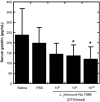A highly acid-resistant novel strain of Lactobacillus johnsonii No. 1088 has antibacterial activity, including that against Helicobacter pylori, and inhibits gastrin-mediated acid production in mice
- PMID: 25771812
- PMCID: PMC4475388
- DOI: 10.1002/mbo3.252
A highly acid-resistant novel strain of Lactobacillus johnsonii No. 1088 has antibacterial activity, including that against Helicobacter pylori, and inhibits gastrin-mediated acid production in mice
Abstract
A novel strain of Lactobacillus johnsonii No. 1088 was isolated from the gastric juice of a healthy Japanese male volunteer, and characterized for its effectiveness in the stomach environment. Lactobacillus johnsonii No. 1088 was found to have the strongest acid resistance among several lactobacilli examined (>10% of cells survived at pH 1.0 after 2 h), and such a high acid resistance property was a specific characteristic of this strain of L. johnsonii. When cultured with various virulent bacteria, L. johnsonii No. 1088 inhibited the growth of Helicobacter pylori, Escherichia coli O-157, Salmonella Typhimurium, and Clostridium difficile, in which case its effectiveness was more potent than that of a type strain of L. johnsonii, JCM2012. In addition to its effect in vitro, L. johnsonii No. 1088 inhibited the growth of H. pylori in human intestinal microbiota-associated mice in both its live and lyophilized forms. Moreover, L. johnsonii No. 1088 suppressed gastric acid secretion in mice via decreasing the number of gastrin-positive cells in the stomach. These results taken together suggest that L. johnsonii No. 1088 is a unique lactobacillus having properties beneficial for supporting H. pylori eradication by triple therapy including the use of a proton pump inhibitor (PPI) and also for prophylaxis of gastroesophageal reflux disease possibly caused after H. pylori eradication as a side effect of PPI.
Keywords: Gastroesophageal reflux disease; Helicobacter pylori; Lactobacillus johnsonii; lactic acid bacteria; probiotics.
© 2015 The Authors. MicrobiologyOpen published by John Wiley & Sons Ltd.
Figures






Similar articles
-
Anti-Helicobacter pylori activity of non-living, heat-killed form of lactobacilli including Lactobacillus johnsonii No.1088.FEMS Microbiol Lett. 2017 Jun 15;364(11). doi: 10.1093/femsle/fnx102. FEMS Microbiol Lett. 2017. PMID: 28505287
-
Eradication of Helicobacter pylori infection by the probiotic strains Lactobacillus johnsonii MH-68 and L. salivarius ssp. salicinius AP-32.Helicobacter. 2012 Dec;17(6):466-77. doi: 10.1111/j.1523-5378.2012.00992.x. Epub 2012 Aug 28. Helicobacter. 2012. PMID: 23067294
-
Synergistic effect of anti-Helicobacter pylori urease immunoglobulin Y from egg yolk of immunized hens and Lactobacillus johnsonii No.1088 to inhibit the growth of Helicobacter pylori in vitro and in vivo.Vaccine. 2019 May 21;37(23):3106-3112. doi: 10.1016/j.vaccine.2019.04.045. Epub 2019 Apr 25. Vaccine. 2019. PMID: 31031029
-
The Esophageal and Gastric Microbiome in Health and Disease.Gastroenterol Clin North Am. 2017 Mar;46(1):121-141. doi: 10.1016/j.gtc.2016.09.009. Gastroenterol Clin North Am. 2017. PMID: 28164846 Review.
-
Helicobacter pylori and gut hormones.J Gastroenterol. 2002;37(2):77-86. doi: 10.1007/s005350200000. J Gastroenterol. 2002. PMID: 11871770 Review.
Cited by
-
The Effects of Lactobacillus johnsonii on Diseases and Its Potential Applications.Microorganisms. 2023 Oct 17;11(10):2580. doi: 10.3390/microorganisms11102580. Microorganisms. 2023. PMID: 37894238 Free PMC article. Review.
-
Gastric acid inhibitor aggravates indomethacin-induced small intestinal injury via reducing Lactobacillus johnsonii.Sci Rep. 2019 Nov 25;9(1):17490. doi: 10.1038/s41598-019-53559-7. Sci Rep. 2019. PMID: 31767915 Free PMC article.
-
Gastroesophageal Reflux Disease and Probiotics: A Systematic Review.Nutrients. 2020 Jan 2;12(1):132. doi: 10.3390/nu12010132. Nutrients. 2020. PMID: 31906573 Free PMC article.
-
The Role of Probiotics in the Eradication of Helicobacter pylori and Overall Impact on Management of Peptic Ulcer: A Study Involving Patients Undergoing Triple Therapy in Bangladesh.Cureus. 2024 Mar 16;16(3):e56283. doi: 10.7759/cureus.56283. eCollection 2024 Mar. Cureus. 2024. PMID: 38495972 Free PMC article.
-
Identification and characterization of potential probiotic lactic acid bacteria isolated from pig feces at various production stages.Can J Vet Res. 2023 Apr;87(2):127-145. Can J Vet Res. 2023. PMID: 37020571 Free PMC article.
References
-
- Aiba Y, Suzuki N, Kabir AM, Takagi A. Koga Y. Lactic acid-mediated suppression of Helicobacter pylori by the oral administration of Lactobacillus salivarius as a probiotic in a gnotobiotic murine model. Am. J. Gastroenterol. 1998;93:2097–2101. - PubMed
-
- Bader J, Albin A. Stahl U. Spore-forming bacteria and their utilisation as probiotics. Benef. Microbes. 2012;3:67–75. - PubMed
-
- Charteris WP, Kelly PM, Morelli L. Collins JK. Development and application of an in vitro methodology to determine the transit tolerance of potentially probiotic Lactobacillus and Bifidobacterium species in the upper human gastrointestinal tract. J. Appl. Microbiol. 1998;84:759–768. - PubMed
-
- De Vuyst L, Vincent P, Makras E, Leroy F. Pot B. Peptide extracts from cultures of certain lactobacilli inhibit Helicobacter pylori. Probiotics Antimicrob. Proteins. 2010;2:26–36. - PubMed
Publication types
MeSH terms
Substances
LinkOut - more resources
Full Text Sources
Other Literature Sources
Molecular Biology Databases
Research Materials

